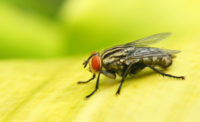TECH FLASH
Dynamic integrated pest management says shoo fly, don’t bother me
A dynamic approach means efficient and long-term resolution.

Modern pest control looks a lot different than it did several decades ago, when chemical pesticides were used to combat pest problems. Integrated pest management (IPM), designed to solve pest problems in the long term, changed the equation for food companies and allowed them to ease off their reliance on chemical applications, which can require significant preparation, downtime and cleanup.
Dynamic integrated pest management (DIPM) takes the long-term nature of IPM one step further by placing an emphasis on modifying the pest management program as the situation and pests change. Chemicals are just one tool in the DIPM toolbox intended to work in concert with a myriad of other methods. The change has had major implications for many food product categories.
According to Dr. James Sargent, director of technical support and regulatory compliance for Copesan, an outstanding IPM program needs to be dynamic and evolving to continue to be successful, and a pest management program based solely on chemistry will ultimately fail.
Unsurprisingly, food safety engineers play a key role in excluding and preventing fly pest problems—the food industry’s worst scourge—and ultimately food contamination. “Sanitary design, good drainage, sound plumbing, light management, temperature management, waste management, positive air pressure, air doors/curtains, door closures and more depend on engineers,” says Sargent. “A successful fly management program monitors for the presence of flies and makes adjustments as needed to the facility.”
For example, if large filth flies are being caught in insect light traps used as monitors, the real question is, how are the flies getting in? Perhaps an air curtain needs adjustment or repair; maybe a screen on a fresh air vent is damaged; maybe a door is being left open; or maybe it’s another of a myriad of simple mechanical issues. A successful DIPM-based fly management program monitors for flies’ presence and makes adjustments as needed.
DIPM must also focus on people and behavioral issues. “Recently, a dairy facility had large numbers of outside insects getting into a certain part of a building that was warm and steamy and had very attractive food odors,” says Sargent. “The insects were getting in when employees were opening a truck door and leaving it open for fresh, cool air. As a solution, a PMP [pest management professional] and a food safety engineer recommended installing a high-speed rollup screen door to allow air ventilation while keeping out the bugs. Preventing the bug problem was a better solution than frequently spraying fly killer insecticide.”
However, even the best engineering solutions require behavioral compliance. In the dairy plant, the new screen door was almost always left open, and flies and other flying insects continued to be present indoors. This demonstrates the fact that great engineering controls would be even better if the human aspect of a current pest problem were considered and included in the IPM program assessment.
The receiving/unloading area is another key location forpest entry into a facility. The first challenge is preventing pest entry through open doors when deliveries are made. The second challenge is preventing pest movement from the unloading area into the rest of the facility. All sorts of pests, including rodents, may be in a delivery or shipment, and they should be prevented from spreading into the rest of the facility.
According to Sargent, one solution is to have delivery trucks and incoming shipments unloaded and opened in an area separated from the rest of the facility. “It’s bad when pests fly or walk into a facility, but it’s equally bad or worse when a pest infestation is inadvertently purchased and delivered to a facility. Each situation is different and needs a custom-designed, dynamic solution for the facility and its incoming pests.”
Since IPM’s adoption as the industry standard, there have been many improvements in product design and engineering to prevent pests and to help keep food safe. There are also improved traps, monitors, exclusion materials, repellents, pesticides and other products to prevent and manage pests. For example, pheromone mating disruption to reduce or eliminate Indian meal moth populations is an excellent new tool to counter a common grain product pest.
Dynamic IPM for constantly changing conditions and pests is the way of the future. It can be implemented through quarterly or regular pest management/food safety team meetings. As soon as possible, arrange a meeting of your food safety team and your pest management provider to review 2013 pest issues and plan for improvements in your pest management program in 2014.
Looking for a reprint of this article?
From high-res PDFs to custom plaques, order your copy today!






